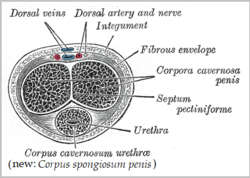This article needs additional citations for verification. (September 2009) |
A corpus cavernosum penis (singular) (from Latin, characterised by "cavities/ hollows"[2] of the penis, pl.: corpora cavernosa) is one of a pair of sponge-like regions of erectile tissue, which contain most of the blood in the penis of several animals during an erection.[3][4][5][6]
| Corpus cavernosum penis | |
|---|---|
 Transverse section of the penis. | |
 The constituent cavernous cylinders of the penis. | |
| Details | |
| Part of | Penis |
| Artery | Cavernous artery[1] |
| Vein | Internal pudendal veins[1] |
| Identifiers | |
| Latin | corpus cavernosum penis |
| TA98 | A09.4.01.014 |
| TA2 | 3678 |
| FMA | 19618 |
| Anatomical terminology | |
It is homologous to the corpus cavernosum clitoridis in the female.
Structure
editThe corpora cavernosa are two expandable erectile tissues along the length of the penis, which fill with blood during penile erection. The two corpora cavernosa lie along the penile shaft, from the pubic bones to the head of the penis, where they join. These formations are made of a sponge-like tissue containing trabeculae, irregular blood-filled spaces lined by endothelium and separated by septum of the penis.[7][8]
The male anatomy has no vestibular bulbs, but instead a corpus spongiosum, a smaller region of erectile tissue along the bottom of the penis, which contains the urethra and forms the glans penis.
Physiology
editIn some circumstances, release of nitric oxide precedes relaxation of muscles in the corpora cavernosa and corpus spongiosum, in a process similar to female arousal. The spongy tissue fills with blood, from arteries down the length of the penis. A little blood enters the corpus spongiosum; the remainder engorges the corpora cavernosa, which expand to hold 90% of the blood involved in an erection, increasing both in length and in diameter. The function of the corpus spongiosum is to prevent compression of the urethra during erection.
Blood can leave the erectile tissue only through a drainage system of veins around the outside wall of the corpus cavernosum. The expanding spongy tissue presses against a surrounding dense tissue (tunica albuginea) constricting these veins, preventing blood from leaving. The penis becomes rigid as a result. The glans penis, the expanded cap of the corpus spongiosum, remains more malleable during erection because its tunica albuginea is much thinner than elsewhere in the penis.
Additional images
edit-
Structure of the penis
-
The deeper branches of the internal pudendal artery.
-
The penis in transverse section, showing the bloodvessels.
-
Male pelvic organs seen from right side.
-
Diagram of the arteries of the penis.
-
Cross section of penis.
-
Medical ultrasonography of a normal penis.
See also
editReferences
edit- ^ a b Panchatsharam, Pranau K.; Durland, Justin; Zito, Patrick M. (1 May 2023). "Physiology, Erection". StatPearls. Treasure Island, Florida: StatPearls Publishing. PMID 30020650. Retrieved 20 November 2023.
- ^ Charlton T. Lewis; Charles Short (eds.). "cavernosus". A Latin Dictionary – via Logeion.
- ^ Hedlund, P.; Matsumoto, K.; Andersson, K. E. (2005). "Animal models of erectile dysfunction". Current Protocols in Pharmacology. Chapter 5: Unit5.41. doi:10.1002/0471141755.ph0541s29. PMID 21953393.
- ^ Werner Lierse (6 December 2012). Applied Anatomy of the Pelvis. Springer Science & Business Media. ISBN 978-3-642-71368-2.
- ^ Heide Schatten; Gheorghe M. Constantinescu (21 March 2008). Comparative Reproductive Biology. John Wiley & Sons. ISBN 978-0-470-39025-2.
- ^ Michele Bertolotto (22 December 2007). Color Doppler US of the Penis. Springer Science & Business Media. pp. 157–. ISBN 978-3-540-36677-5.
- ^ "Embarrassing erections". 2007-01-17. Archived from the original on 2007-01-02. Retrieved 2007-01-17.
- ^ "Understanding a man's erection". whitelotuseast. Archived from the original on 2020-07-16. Retrieved 2011-05-18.[better source needed]
External links
edit- Anatomy photo:42:st-1102 at the SUNY Downstate Medical Center - "The Male Perineum and the Penis: Penis"